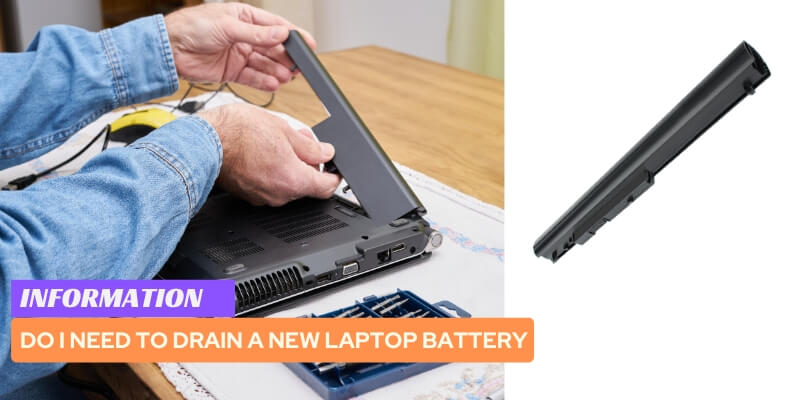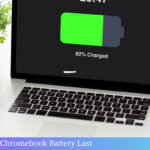No, it is not necessary to drain a new laptop battery. Proper charging habits are more important for battery lifespan and performance.
Introducing a new laptop into your life can be an exciting time, but it can also come with a lot of questions.
One common query is whether they need to drain their new laptop battery before using it for the first time.
We will provide you with a clear and concise answer to this question. We will also discuss the importance of proper charging habits for maximizing the lifespan and performance of your laptop battery.
So, without further ado, let’s discover if draining a new laptop battery is necessary.
Table of Contents
Understanding The Battery Draining Myth
In today’s technologically advanced world, laptops have become an indispensable tool for work, entertainment, and staying connected.
One of the common questions that often arises when purchasing a new laptop is whether it is necessary to drain the battery before using it.
Various misconceptions and myths surround this topic, causing confusion among laptop users.
In this article, we will explore the misconceptions surrounding new laptop battery drainage, debunk the myths about battery calibration, and highlight the importance of understanding lithium-ion battery technology.
1. Exploring the Misconceptions Surrounding New Laptop Battery Drainage
When it comes to new laptop battery drainage, there are several misconceptions that need to be clarified.
Let’s take a closer look at each of them:
- Myth 1: It is essential to drain the battery completely before using a new laptop.
- Myth 2: Not draining the battery fully can reduce battery life.
- Myth 3: The “memory effect” requires complete drainage to maintain battery health.
These misconceptions often stem from the old nickel-cadmium (NiCad) battery technology, which had memory effect issues.
However, modern laptops use lithium-ion batteries, which do not suffer from this problem.
2. Debunking the Myths about Battery Calibration
Battery calibration is another aspect that is often misunderstood. Here are the truths behind the common myths:
- Myth 1: Calibrating the battery by fully draining and recharging it periodically is necessary.
- Myth 2: Frequent battery calibration can significantly improve battery life.
In reality, lithium-ion batteries do not require frequent calibration. Modern laptops and operating systems come equipped with advanced battery management systems that automatically optimize battery performance.
Draining the battery completely regularly can even be harmful to its overall lifespan. It is best to follow the manufacturer’s recommendations for battery usage and charging cycles.
3. Importance of Understanding Lithium-ion Battery Technology
In order to make informed decisions about battery usage, it is crucial to have a basic understanding of lithium-ion battery technology.
Here are a few key points to keep in mind:
| Lithium-ion Battery Technology |
|---|
| – Lithium-ion batteries do not have memory effect issues. |
| – They are designed to be used and charged frequently. |
| – Avoid extreme temperatures, as they can degrade battery performance. |
| – Charging the battery between 20% and 80% is recommended for optimal lifespan. |
By understanding these fundamental aspects of lithium-ion batteries, you can ensure the longevity and performance of your laptop battery.
So, the next time you purchase a new laptop, don't get caught up in the battery-draining myth.
Instead, focus on understanding the technology behind your laptop’s battery and following the manufacturer’s guidelines for optimal usage and longevity.
This way, you can enjoy your laptop fully without worrying about unnecessary battery draining or calibration.
Get Your Laptop Battery Ready For First Use
Preparing your laptop battery for its maiden voyage is critical to ensuring optimal performance and longevity.
Whether you recently purchased a new laptop or replaced your old battery, this guide will walk you through the important steps to prepare your laptop battery for first-time use.
From initial charging to calibration to maintenance, we provide knowledge and tips to properly initialize your laptop power supply.
A healthy battery not only extends the lifespan of your device, but also improves its efficiency, making it a reliable partner for work, study and leisure. Start this powerful journey.
1. Unboxing and Setting Up Your New Laptop Battery
When you purchase a brand-new laptop, it’s essential to properly set up the battery for optimal performance. Begin by unboxing your laptop and locating the battery.
Usually, the battery comes pre-installed in the laptop, but if it’s not already inserted, carefully follow the manufacturer’s instructions to place it correctly.
Next, connect your laptop to a power source using the supplied power adapter. It’s essential to ensure a stable power connection during the initial charging process.
2. Initial Charging Process for Optimal Performance
Once your laptop is connected to a power source, allow the battery to charge fully. During this initial charging process, please avoid using the laptop or unplugging it until the battery reaches 100%. This step is crucial to calibrate the battery and achieve maximum capacity.
Bold your essential phrases: allow the battery to charge fully, avoid using the laptop or unplugging it, and the battery reaches 100%, and maximum capacity.
3. Checking the Battery Health Status
After completing the initial charging process, it’s advisable to check the battery’s health status to ensure it’s functioning optimally.
Different laptops may have varying methods for checking battery health. Refer to your laptop's user manual or manufacturer's website for specific instructions.
If the battery health check reveals any issues or abnormalities, it’s essential to address them promptly.
This may involve contacting customer support or taking the laptop to an authorized service center for further examination and potential replacement.
4. Verdict
In conclusion, when you first unbox a new laptop, setting up the battery correctly is crucial to ensure optimal performance.
This includes:
- Properly inserting the battery.
- Fully charging it during the initial charging process.
- Checking its health status.
By following these steps, you can maximize the lifespan and efficiency of your laptop battery.
Best Practices For Maximizing Battery Life
When it comes to maximizing your new laptop’s battery life, you can follow several best practices.
By adjusting power settings, managing background apps and processes, and utilizing battery-saving modes, you can ensure that your laptop stays powered for longer without needing constant recharging.
1. Adjusting power settings to conserve battery life
To conserve battery life, it is vital to optimize your laptop’s power settings. You can significantly extend your battery’s lifespan by making a few adjustments.
Here are some power settings that you can tweak:
- Lower screen brightness: Reducing the brightness of your laptop’s screen can significantly impact battery usage. Try setting it to a lower level that is still comfortable for your eyes.
- Adjust power plan: Most laptops have power plans such as “Power Saver” or “Balanced” that you can select according to your needs. The “Power Saver” plan typically reduces performance to conserve battery, while the “Balanced” plan offers a balance between performance and battery life.
- Turn off keyboard backlight: If your laptop has a backlit keyboard, consider turning it off when not in use. The backlight can consume a significant amount of battery power.
2. Managing background apps and processes
In order to maximize battery life, it is essential to check background apps and processes that may be running unnecessarily.
These apps and processes can consume valuable system resources and drain your battery faster.
Here are a few tips to manage them:
- Close unnecessary apps: Make sure to close any applications that you are not actively using. This includes web browsers, media players, and other software running in the background.
- Disable startup programs: Many applications habitually start up when you turn on your laptop. Disable any unnecessary startup programs to minimize the load on your system resources.
- Monitor task manager: Keep an eye on the Task Manager utility to identify any resource-intensive processes that are running in the background. Close or limit the impact of these processes.
3. Utilizing battery-saver modes
Most laptops come equipped with battery-saving modes that can be activated to conserve power. Enabling these modes can significantly extend your laptop’s battery life.
Here’s how to make the most of them:
- Activate battery saver mode: Enable the battery saver mode on your laptop whenever you are running low on battery. This mode typically reduces the performance of your system and minimizes background activities to preserve battery life.
- Customize battery-saver settings: Some laptops allow you to customize the settings of the battery-saver mode. Adjusting options, such as screen brightness and background app restrictions, can help you balance performance and battery life.
- Enable hibernation mode: Instead of putting your laptop to sleep mode, consider enabling hibernation mode when you are not actively using it. Hibernation mode saves your current work and shuts down the laptop, consuming minimal battery power.
By following these best practices for maximizing battery life, you can ensure that your new laptop remains powered for longer periods without draining the battery completely.
Take control of your laptop’s power settings, check background apps and processes, and make the most of battery-saving modes to make your laptop battery last longer.
Proper Storage And Usage Of Laptop Batteries
Laptop batteries are a vital component that keeps your device powered up and running smoothly.
To ensure their longevity and performance, it is crucial to understand the proper storage and usage of laptop batteries.
By following some simple guidelines, you can extend the lifespan of your laptop battery and avoid common issues such as diminished battery life and sudden power drainage.
1. Tips for storing laptop batteries when not in use
When you are not using your laptop for an extended period, it is essential to store the battery correctly to maintain its health.
Here are some tips to keep in mind:
- Remove the battery from the laptop if it will be unused for more than a month.
- Keep the battery cool and dry, away from excessive heat and moisture.
- Store the battery in a plastic bag or container to protect it from dust and dirt.
- Ensure the battery is charged to around 50-70% before storing it.
- Check the battery periodically and recharge to half capacity if its charge level drops significantly.
2. Impact of extreme temperatures on battery health
Extreme temperatures can significantly impact the health and lifespan of laptop batteries. Here’s what you need to know:
| Temperature | Effect on Battery |
|---|---|
| High Temperatures | Accelerate the degradation of battery capacity over time. |
| Low Temperatures | Reduce battery performance and lifespan temporarily. |
To protect your laptop battery from extreme temperatures, avoid exposure to direct sunlight, intense cold, or heat sources like heaters or radiators.
This will help maintain its performance and extend its overall lifespan.
3. Handling and usage guidelines to extend battery lifespan
Proper handling and usage play a crucial role in extending the lifespan of your laptop battery. Here are some guidelines to follow:
- Avoid draining the battery completely before recharging. Instead, aim to recharge it when it reaches around 20-30% capacity.
- Avoid overcharging the battery, as it can lead to battery degradation over time.
- Use the laptop on a stable surface that allows proper airflow, avoiding overheating the battery.
- Minimize resource-intensive applications and adjust power settings to optimize battery performance.
- Regularly update your laptop’s operating system and firmware, as software updates often include optimizations for battery usage.
By adhering to these guidelines, you can ensure that your laptop battery remains in optimal condition, providing you with reliable performance and extended battery life.
Maintaining Battery Health Over Time
When you first purchase a new laptop, one of the most important aspects to consider is the battery life.
A healthy battery ensures your laptop can last through multiple work sessions or entertainment purposes without constant charging.
It is crucial to follow certain practices to maintain the longevity and performance of your laptop battery. One of the critical aspects to consider is keeping the battery healthy over time.
1. Regular usage patterns for long-term battery maintenance
Developing regular usage patterns for your laptop battery can significantly contribute to its long-term maintenance
It is recommended to avoid continually draining the battery until it is fully depleted or unnecessarily charging it to maximum capacity.
Instead, aim to maintain your battery at a level between 20% and 80%, as this range facilitates optimal performance and longevity.
By adhering to regular usage patterns, you can extend the overall lifespan of your laptop battery.
2. Avoiding deep discharges for better battery health
Deep discharges, where the battery is drained to 0% before recharging, can adversely affect the health of your laptop battery over time.
These deep discharges can cause the battery to deteriorate, resulting in a shorter lifespan. To avoid this, charging your laptop when the battery level reaches around 20% to 30% is advisable.
Doing so prevents the battery from entering a very low state of charge and thus maintains its health in the long run.
3. Monitoring battery health and performance using diagnostic tools
Monitoring the health and performance of your laptop battery is crucial for its overall maintenance.
Many laptops come equipped with built-in diagnostic tools that provide valuable information about the battery’s condition.
These diagnostic tools can display essential metrics such as the battery's overall health, charge cycle count, and remaining capacity.
By regularly checking these metrics, you can ensure that your battery is functioning optimally and take any necessary steps to maintain its health.
Maintaining the health of your laptop battery over time is vital for its long-term performance and lifespan.
By following regular usage patterns, avoiding deep discharges, and monitoring battery health using diagnostic tools, you can ensure that your battery remains in optimal condition.
Implementing these practices will not only extend the overall longevity of your battery but also provide you with a reliable and long-lasting laptop experience.
Troubleshooting Common Laptop Battery Issues
Have trouble with your laptop battery? Don’t worry, you’re not alone. Laptop battery issues are not uncommon, and several common issues can arise.
In this section, we’ll identify these common issues and their potential causes, provide solutions for battery drain, low runtime, and other problems, and discuss when it might be time to consider replacing your laptop battery.
1. Identifying common issues and their potential causes
Before we dive into troubleshooting laptop battery issues, it’s important to first identify the problem and what could potentially be causing it.
Here are some common issues you might encounter:
| Common Issue | Potential Cause |
|---|---|
| Battery drain | Background processes, excessive usage, improper power settings |
| Low runtime | Old battery, high power consumption, power-hungry applications |
| Overheating | Blocked air vents, heavy usage, faulty cooling system |
| Inaccurate battery percentage | Calibration issues, software glitches |
2. Solutions for battery drain, low runtime, and other problems
If you’re experiencing battery drain, low runtime, overheating, or inaccurate battery percentage, here are some solutions to help troubleshoot these issues:
- Battery drain: Close unnecessary background processes, adjust power settings to optimize battery life, and avoid excessive usage.
- Low runtime: Consider replacing an old battery, closing power-hungry applications or processes, reducing screen brightness, and disabling unnecessary features or peripherals.
- Overheating: Clean air vents to ensure proper airflow, minimize heavy usage or resource-intensive tasks, and check the cooling system for any issues or malfunctions.
- Inaccurate battery percentage: Calibrate your battery by fully charging and discharging it a few times, and update or reinstall battery monitoring software if necessary.
3. When to consider replacing your laptop battery
In some cases, troubleshooting provides temporary relief for battery issues. Consider replacing your laptop battery if you’ve tried various solutions and still encounter persistent problems.
Common signs that indicate it’s time for a new battery include:
- The battery no longer holds a charge for a reasonable amount of time.
- Intense battery drain even when the laptop is not in use.
- Noticeable physical damage or swelling of the battery.
- Frequent unexpected shutdowns or sudden power loss.
Remember, replacing a laptop battery is generally a straightforward process, and it’s always best to consult your laptop’s manufacturer or a certified technician for guidance and to ensure compatibility.
Frequently Asked Questions Of Do I Need To Drain A New Laptop Battery
Should You Drain Your New Laptop Battery?
What Is The Best Way To Use A New Laptop Battery?
Should I Drain My Battery Before Charging Laptop?
How Long Should I Charge A New Laptop Battery For The First Time?
Can I Use My New Laptop While It’s Plugged In?
Should I Drain My New Laptop Battery Completely Before Charging?
How Often Should I Fully Charge My New Laptop Battery?
Can I Overcharge My New Laptop Battery?
Do I Have To Keep My New Laptop Plugged In To Charge It Fully?
Is It Okay To Leave My New Laptop Charging Overnight?
Conclusion on Do I Need To Drain A New Laptop Battery
While it was once considered necessary to drain a new laptop battery, technological advancements have rendered this practice obsolete.
Modern laptops are equipped with advanced lithium-ion batteries that do not require the initial draining process.
Instead, using and charging the battery as needed is recommended, without worrying about completely draining it.
This ensures optimal performance and longevity of the battery. However, it is important to note that overcharging the battery can also be detrimental, so it is best to unplug the laptop once it reaches full charge.
By following these simple guidelines, you can maximize the battery life of your new laptop and enjoy uninterrupted usage.
Keep in mind that each laptop may have different specifications, so it is always a good idea to consult the manufacturer’s guidelines for specific information on battery care.






